Veröffentlichungen von Dr. Christoph Weinert
Journal-Artikel (Peer Reviewed)
Weinert, C., Maier, C., Laumer, S., and Weitzel, T.
(2024)
How Embeddedness Influences IT-Induced Work–Home Boundary Reduction, Work–Home Conflict, and Job Outcomes
Information & Management (61:3), , https://doi.org/10.1016/j.im.2024.103929 (VHB-JOURQUAL 3 Rating: B)
View AbstractWork–home conflict (WHC) explains how IT use blurs the boundaries between work and private roles. We extend that knowledge by highlighting the importance of work–home embeddedness (WHE) and its impact on WHC. Drawing on boundary theory, we hypothesize that IT-induced work–home boundary reduction (IT-WHBR) exacerbates WHC, influencing job outcomes. Utilizing embeddedness theory and data from 862 individuals, we categorize three distinct WHE groups. Our findings clarify how IT-WHBR shapes WHC and how diverse WHE groups moderate the relationship between IT-WHBR, WHC, and job outcomes. This paper significantly contributes to existing literature by revealing dynamics within work-home interactions.
Weinert, C., and Weitzel, T.
(2023)
Teleworking in the Covid-19 pandemic: The Effects of Life-Work Conflict on Job Outcomes and the Role of the IT Telework Environment
Business & Information Systems Engineering (BISE) (65:1), p.309-328, https://doi.org/10.1007/s12599-023-00800-3 (VHB-JOURQUAL 3 Rating: B)
View AbstractTeleworkers who live and work in the same space are vulnerable to conflicts between personal life and work (LWC). The Covid-19 lockdowns increased the intensity and risk of LWC and changed telework conditions, confronting teleworkers with difficult personal situations and often ill-equipped telework environments. To develop a better understanding of the effects of different LWC dimensions (e.g., time, strain, behavior) on work exhaustion, job satisfaction, routine and innovative job performance and the role of the IT telework environment among teleworkers in the Covid-19 pandemic, we develop and validate a research model based on a sample of 249 teleworkers. Our findings show that LWC has adverse effects on job outcomes and that the IT telework environment moderates these effects. We contribute to the telework and role conflict literature by revealing the essential role of the IT telework environment and by differentiating between routine and innovative job performance among teleworkers.
Weinert, C., Maier, C., Laumer, S., and Weitzel, T.
(2022)
Repeated IT Interruption: Habituation and Sensitization of User Responses
Journal of Management Information Systems (39:1), p.187-217, http://dx.doi.org/10.1080/07421222.2021.2023411 (VHB-JOURQUAL 3 Rating: A)
View AbstractInformation technology (IT) interruptions are IT-based events that capture users’ attention and interfere with other activities. This study focuses on repeated IT interruption and task performance. We draw on dual-process theory and suggest that users may get used to repeated IT interruption, known as habituation, or may become hypersensitive, known as sensitization. We validate the research model based on data from a laboratory experiment with 100 subjects by using a multivariate latent growth model (LGM). With subjective and objective measurement techniques, we show how users respond to repeated IT interruption with physiological arousal, psychological exhaustion, and behavioral task performance. Our results indicate that user responses follow different patterns over time, revealing time-dependent effects of arousal and exhaustion on task performance. We contribute to literature by providing evidence that repeated IT interruption results in unique habituation and sensitization user response patterns compared to a single IT interruption.
Maier, C., Laumer, S., Thatcher, J.B., Sun, H., Weinert, C., and Weitzel, T.
(2021)
Social Networking Site Use Resumption: A Model of Return Migration
Journal of the Association for Information Systems (JAIS) (22:4), p.1037-1075, https://doi.org/10.17705/1jais.00688 (VHB-JOURQUAL 3 Rating: A)
View AbstractThis research explains why individuals resume using social networking sites (SNSs) after terminating their use. Drawing on return migration theory, we developed a theory-driven model of SNS resumption that includes two novel antecedents of SNS resumption behavior: nonuse-related dissatisfaction and use-related satisfaction. We also hypothesize that dispositional resistance to change moderates the impact of nonuse-related dissatisfaction and use-related satisfaction on resumption. We used a mixed methods approach to refine and evaluate the research model. Study 1 used the critical incident method to identify SNS-specific antecedents of nonuse-related satisfaction and use-related satisfaction, allowing us to refine the research model. Study 2 used structural equation modeling to evaluate our research model using two three-wave surveys: one with recent ex-users who recently decided to stop using and delete their profiles on Facebook and one with long-standing ex-users who stopped using and deleted their profiles on Facebook a long time ago. We found support for most relationships in our model: nonuse-related dissatisfaction and use-related satisfaction drive resumption intentions, and dispositional resistance moderates these relationships. Furthermore, we found that the time elapsed since users discontinued Facebook moderated these relationships such that the effect of nonuse-related dissatisfaction on resumption intention is stronger for recent ex-users and the effect of use-related satisfaction is stronger for long-standing ex-users. Our findings advance the understanding of resumption, an understudied behavior of the IT lifecycle and IT use and acceptance research.
Weinert, C., Maier, C., Laumer, S., and Weitzel, T.
(2020)
Technostress mitigation: an experimental study of social support during a computer freeze
Journal of Business Economics (JBE) (90:8), p.1199-1249, http://dx.doi.org/10.1007/s11573-020-00986-y (VHB-JOURQUAL 3 Rating: B)
View AbstractIn situations when Information Systems (IS) do not work as intended, using IS might hinder their users and let them perceive technostress; this then comes along with reduced user performance and high perceptions of exhaustion, among others. To alleviate these consequences, a mitigating behavior of stressed users is to seek social support to get instrumental (e.g., from the help desk) or emotional (e.g., consolation) backing. Using insights from psychology literature that suggest social support reduces the consequences of stressors, this paper investigates how instrumental and emotional support reduces the consequences of techno-stressors, such as reduced end-user performance, techno-exhaustion, and physiological arousal, caused by techno-unreliability such as a computer freeze. In a laboratory setting, measurements of skin conductance were used to evaluate the technostress of 73 subjects, manipulated by techno-unreliability and then treated with instrumental and emotional support. The findings indicate that social support increased end-user performance as well as reduced techno-exhaustion and physiological arousal. In particular, instrumental support directly influenced end-user performance, techno-exhaustion, and physiological arousal, whereas emotional support only influenced techno-exhaustion. Further, this study provides the first indications that the effect of social support on technostress depends on individual differences.
Weinert, C., Maier, C., Laumer, S., and Weitzel, T.
(2020)
IS Reappraisal and Technology Adaptation Behaviors: A Longitudinal Study During an IS Implementation
ACM SIGMIS Database (51:4), p.11-39, http://dx.doi.org/10.1145/3433148.3433151 (VHB-JOURQUAL 3 Rating: B)
View AbstractEmployees have to adapt to newly implemented information systems (IS) because they are often perceived as radical changes or disruptions. To understand such adaptation behavior, IS research suggests that employees first appraise the new IS and second perform technology adaptive behaviors. However, while the psychology literature indicates that adaptation is a continuous process unfolding over time, previous IS literature treats adaptation towards IS implementation as a rather singular, noniterative process. As firms continue to implement IS, an understanding of reappraisal and the influence of technology adaptation behavior is vital to ensure successful implementations. Therefore, the present paper investigates reappraisal and the influences of four different technology adaptation behaviors. We conducted a longitudinal study and used hierarchical linear modeling (HLM) to validate our research model. The findings reveal that employees reappraise the newly implemented IS over time regarding perceived opportunity, threat, and controllability and demonstrate that technology adaption behaviors influence such reappraisal. One specific finding is that employees might get into positive or negative reappraisal loops. We thereby contribute to research by extending the adaptation behavior literature and add a new piece of the puzzle to understand how employees adapt towards newly implemented IS over time.
Maier, C., Laumer, S., Weinert, C., and Weitzel, T.
(2015)
The Effects of Technostress and Switching-stress on Discontinued Use of Social Networking Services: A Study of Facebook Use
Information Systems Journal (ISJ) (25:3), p. 275-308, http://dx.doi.org/10.1111/isj.12068 (VHB-JOURQUAL 3 Rating: A)
View AbstractAlthough much research has been done on the adoption and usage phases of the IS life cycle, the final phase, termination, has received little attention. This paper focuses on the development of discontinuous usage intentions, i.e. the behavioral intention in the termination phase, in the context of social networking services (SNSs), where it plays an especially crucial role. We argue that users stressed by using SNSs try to avoid the stress and develop discontinuous usage intentions, which we identify as a behavioral response to SNS-stress creators and SNS-exhaustion. Furthermore, as discontinuing the use of an SNS also takes effort and has costs, we theorize that switching-stress creators and switching-exhaustion reduce discontinuous usage intentions. We tested and validated these effects empirically in an experimental setting monitoring individuals who stopped using Facebook for a certain time period and switched to alternatives. Our results show that SNS-stress creators and SNS-exhaustion cause discontinuous usage intentions, and switching-stress creators and switching-exhaustion reduce these intentions.
Laumer, S., Beimborn, D., Maier, C., and Weinert, C.
(2013)
Enterprise Content Management
Business & Information Systems Engineering (BISE) (5:6), p. 449-452, http://link.springer.com/article/10.1007/s12599-013-0291-3 (VHB-JOURQUAL 3 Rating: B)
Laumer, S., Beimborn, D., Maier, C., and Weinert, C.
(2013)
Enterprise-Content-Management
WIRTSCHAFTSINFORMATIK (55:6), p. 453-456, http://link.springer.com/article/10.1007/s11576-013-0384-0 (VHB-JOURQUAL 3 Rating: B)
Konferenz-Artikel (Peer Reviewed)
Bayor, L., Weinert, C., Maier, C., and Weitzel, T.
(2024)
A Pal and a Confidant? Social Communication between Humans and Machines
Proceedings of the 32nd European Conference on Information Systems (ECIS), Paphos, Cyprus
(Research in Progress)
View AbstractMachines such as AI companions, equipped with enhanced cognitive capabilities, can now be considered as an equal communicative subject that is capable of social communication. To take account of this, we will unfold what benefits and costs are associated with engaging in social communication with a machine. This research-in-progress paper employs a qualitative research design based on social exchange theory to give theoretical insights. We expect to contribute with this research by revealing the costs and benefits of social communication in the human-machine communication context, developing an understanding of how the cost-benefit calculation differs within the context of social communication between humans and machines, and contributing to the upcoming research stream on AI companions.
Gimnich, M., Weinert, C., and Weitzel, T.
(2024)
It’s a Trap!? Causes and Consequences of Filter Bubbles
Proceedings of the 32nd European Conference on Information Systems (ECIS), Paphos, Cyprus
View AbstractFilter bubbles result from recommender systems, which filter information based on a user’s behavior and preferences. However, scientific research lacks a comprehensive understanding of filter bubbles due to conflicting definitions, processes, and consequences of this phenomenon. Therefore, we addressed this issue by conducting a comprehensive literature review encompassing high-ranked information systems research, covering relevant journals and conferences. Through this process, we constructed a concept matrix delineating the causes and consequences of filter bubbles. Based on these findings, we developed a research agenda suggesting four areas for future research. The paper contributes to the literature on filter bubbles by providing conceptual clarity and insights into their causes and consequences at individual, organizational, and societal levels.
Jung, C., Schoch, M., and Weinert, C.
(2023)
The Dynamics of IT Use: Uncovering the Interplay between the Perception of IT Events, Emotions, and Cognitive Absorption over Time
Proceedings of the 44th International Conference on Information Systems (ICIS), Hyderabad, India
(Research in Progress)
View AbstractEmotions triggered by IT events have a decisive influence on IT use. Previous literature has focused on one point in time studies investigating the relationship between emotions and IT use. However, the process of perceiving an IT event, leading to emotions and changes in IT use proceeds dynamically over time. This research in progress paper concentrates on this process. We investigate how the change in perception of an IT event affects emotions, and IT use over time. Therefore, we develop an online experiment simulating time pressure as an example of an IT event. During the experiment, data is collected at four different points in time. The data will be analyzed with a multivariate longitudinal latent growth model. We aim to enhance the current literature by capturing the dynamic changes in perceiving IT events, emotional responses, and subsequent changes in IT use over time.
Schoch, M., and Weinert, C.
(2023)
IT-related time poverty: Identifying antecedents and consequences of a lack of time related to IT use
Proceedings of the 18th International Conference on Wirtschaftsinformatik, Paderborn, Germany
View AbstractTime poverty is the subjective perception of inadequate freely disposable time, which results in negative consequences for individuals. Although in-formation systems (IS) research knows that information technology (IT) use change time perception, research is incomplete in explaining IT-related antecedents and consequences of time poverty. Because time is a scarce resource, individuals, organizations, and society have a responsibility to manage time to protect individuals from adverse consequences. We conduct a structured literature re-view to identify indications of how IT use influences time poverty and its adverse consequences. We identified 16 papers, which we analyzed with respect to different components of IT use and possible consequences of time poverty. Based on the data, we develop an overview of the antecedents and consequences of IT-related time poverty and a research agenda. We contribute to the research by introducing IT-related time poverty as a new IS construct and providing an in-depth research agenda.
Bayor, L., Weinert, C., Maier, C., and Weitzel, T.
(2023)
SNS Guilt Feelings: Causes and Influence on Discontinuance
Proceedings of the 29th Americas Conference on Information Systems (AMCIS), Panama City, Panama
View AbstractAlthough experiencing guilt feelings after social networking service (SNS) usage has become a prevalent phenomenon among SNS users, these SNS guilt feelings - and especially their causes - have received little scholarly attention. This paper therefore focuses on why SNS users may develop SNS guilt feelings and their impact on discontinuance intention. We utilize the lens of normative dissociation to develop a model to identify causes of SNS guilt feelings and apply a quantitative research approach to test the model. We contribute by demonstrating that two identified causes - perceived time spent and perceived procrastination – significantly influence SNS guilt feelings, while perceived meaningfulness does not. Furthermore, SNS guilt feelings influence discontinuance intention and mediate the relationship between several constructs and discontinuance intention. By employing the perspective of normative dissociation, we reinforce the relevance of SNS guilt feelings.
Bayor, L., Weinert, C., Maier, C., and Weitzel, T.
(2022)
Affective Responses and IS Continuance
Proceedings of the Special Interest Group on Adoption and Diffusion of Information Technology (DIGIT) (Pre-ICIS Workshop), Copenhagen, Denmark
View AbstractIS research increasingly recognizes that affective responses play an important role in explaining continuance intention. However, most research disregards the variety and complexity of affective responses. Encountering models with multiple affective responses included is scarce, and possible relationships among different affective responses are neglected. This paper develops a model measuring continuance intention in the context of fitness applications using three fundamentally different, but complementary affective responses: IS satisfaction, deep engagement, and meaningful engagement. An empirical investigation using an online survey is conducted. The findings demonstrate that different affective responses influence continuance intention in distinct ways, and that there are interrelations between affective responses. Deep engagement and IS satisfaction have a direct influence on continuance intention, and there is an indirect relationship between meaningful engagement and continuance intention mediated by IS satisfaction. Contributions to theory and practice are discussed.
Weinert, C., and Schoch, M.
(2022)
How do successful coping change appraisal and user responses?
Proceedings of the 43rd International Conference on Information Systems (ICIS), Copenhagen, Denmark
(Research in Progress)
View AbstractTechnostress research asserts that the use of information systems (IS) can be challenging or hindering. Previous literature has mostly focused on the challenge or hindrance subprocesses. However, research suggests that these subprocesses may interact with each other. Positive user responses can be derived from events that were originally perceived as hindering. The present research-in-progress paper focuses on this interaction. We investigate whether successful coping – the elimination of a stressful IS use situation – leads to positive user responses in the hindering subprocess. Therefore, we develop an online experiment, which emulates different IS use situations. A hindrance techno-stressor situation (HTS), a control situation without a techno-stressor (non-HTS), and one in which users can successfully cope with the hindrance techno-stressor (SC). The experiment allows us to analyze the interactions between the subprocesses. We expect to contribute to the literature on technostress and IS coping by focusing on the interaction between the two subprocesses.
Schreyer , N., and Weinert, C.
(2022)
Breaking Out of the Social Media Prison: Identifying Strategies to Disrupt the IT-Mediated State-Tracking Habit
Proceedings of the 28th Americas Conference on Information Systems (AMCIS), Minneapolis (MN), United States
View AbstractIn recent times, the negative consequences of social network sites (SNS) including social overload, loss of self-control and technology addiction caused problematic usage behavior. Combined with the new phenomenon of IT-mediated state-tracking, the habit of constantly checking for new updates has a rising impact in terms of information technology (IT) usage on the society. Since there is a lack of theoretical insights on how to break checking habits, strategies have been developed to disrupt the user's habit of compulsive and excessive usage. To provide insights on this topic, a literature review has been conceived which invests Information System (IS) journals and IS conferences. The results show six disruption strategies. The paper's findings contribute conceptually to the existing IT literature including an illustration from which users can derive important and useful guides to disrupt their IT-mediated state-tracking habits.
Ilek, T., Maier, C., and Weinert, C.
(2022)
Electronic Human Resource Management: A Literature Analysis of Drivers, Challenges, and Consequences.
Proceedings of the 17th International Conference on Wirtschaftsinformatik, Nürnberg, Germany
View AbstractThere have been significant changes in how human resources (HR) are managed in the last decade. Electronic Human Resource Management (e-HRM) systems are implemented to support the HR organization digitally. However, e-HRM projects fail frequently. This requires attention as e-HRM systems are essential for organizations to drive the digitalization of HR and thereby ensure competitiveness. The reasons for project failure are unclearly defined project drivers and improperly handled challenges. Furthermore, the consequences of e-HRM are often not well understood and communicated. Therefore, we assume a lack of comprehensive understanding of drivers, challenges, and consequences of e-HRM concerning the organization and the individual. Thus, we analyze the last ten years of e-HRM research and use a structured way to identify eleven drivers, twelve challenges, and twenty consequences of e-HRM. We cluster these findings in an e-HRM synthesis and contribute to e-HRM research by providing
avenues for future research on e-HRM success.
Weinert, C., and El-Robrini, N.
(2021)
Challenge and hindrance coping: explaining how users cope with positive and negative technostress
Proceedings of the 29th European Conference on Information Systems (ECIS), A Virtual AIS Conference
View AbstractRecent technostress literature points out the necessity to examine the positive side of technostress besides its well-known negative side. Therefore, the literature introduces challenge techno-stressors (CTS), appraised as opportunities, and hindrance techno-stressors (HTS), appraised as a hindrance towards personal accomplishment. However, recent investigations show how coping strategies regulate HTS but neglect how users cope with CTS and the conceptual differences between challenge and hindrance coping strategies. The paper develops a challenge and hindrance coping model theorizing that CTS leads to challenge coping (i.e., active coping) and then to positive outcomes (e.g., end-user performance). In contrast, HTS leads to hindrance coping (i.e., denial) and subsequently to negative outcomes (e.g., techno-exhaustion). The findings demonstrate that CTS increases active coping and reduces denial. HTS increases only denial. Regarding the outcomes, active coping increases end-user performance, whereas denial reduces end-user performance and increases techno-exhaustion. The contributions to theory and practice are discussed.
Weinert, C., Pflügner, K., and Maier, C.
(2020)
Do users respond to challenging and hindering techno-stressors differently? A laboratory experiment
Proceedings of the 2020 NeuroIS Retreat, Vienna, Austria
(Research in Progress)
View AbstractTechno-stressors are typically hindering for users. These then cause adverse user responses, such as techno-exhaustion, which in turn result in reduced task performance. Latest technostress research adds two types of stressors: hindrance techno-stressors (HTS) and challenge techno-stressors (CTS). Using that knowledge, this research-in-progress paper develops a research model assuming that both types of techno-stressors lead to different user responses (e.g., motivation, techno-exhaustion, arousal) and, in turn, have a different impact on task performance. To validate that empirically, we propose a mixed-experimental research design following a pre-post approach with three different treatments (e.g., HTS, CTS, control) using among other different biomarkers (e.g., SC, sAA, cortisol) to measure arousal. The expected contributions and future steps are discussed.
Weinert, C., and Weitzel, T.
(2019)
How do users cope with technostress over time? A longitudinal study investigating the intra-individual effects of technostress mitigation
Proceedings of the Special Interest Group on Adoption and Diffusion of Information Technology (DIGIT) (Pre-ICIS Workshop), Munich, Germany
(Research in Progress)
Weinert, C., Maier, C., Laumer, S., and Weitzel, T.
(2019)
How do Users Respond to Technostress? An Empirical Analysis of Proactive and Reactive Coping
Proceedings of the Hawaii International Conference on System Sciences (HICSS), Maui, USA
View AbstractAs technostress costs organizations financial resources and threatens the well-being, it is essential for users as well as companies to manage technostress. To do so, users cope proactive by removing or reducing techno-stressors or reactive by restoring users' emotional state. However, literature is limited by explaining what factors lead to proactive and reactive coping in a short-term technostress situation. The present paper addresses these shortcomings by investigating in how techno-stressors and emotional exhaustion influences proactive and reactive coping. Results based on 110 users show that users respond to techno-stressors in a proactive way, whereas users reactively respond to emotional exhaustion. In addition, proactive coping is stronger affected by techno-stressors, and reactive coping is stronger affected by emotional exhaustion. Thereby, we contribute to technostress and coping literature by demonstrating how users respond in short-term technostress situation and highlight the importance of time in the present context.
Weinert, C.
(2018)
Improving the IS Literature Rigor on Habit by Looking Through the Theoretical Lens of the Dual-Process Theory
Proceedings of the Special Interest Group on Adoption and Diffusion of Information Technology (DIGIT) (Pre-ICIS Workshop), San Francisco, USA
(Research in Progress)
View AbstractInformation system (IS) usage has been extensively researched for decades. These theories are built upon the assumption that human decisions are based only on rationality. However, this notion was challenged in more recent years, as Kahneman (2003) demonstrates that human decisions are not only based on rationality but also on intuition. Kahneman's dual-process theory suggests that cognitive processes underlying social judgments and behavior can be divided into two different systems (system one and system two) depending on whether they operate reflectively or intuitively. Yet, prior IS usage literature examines the construct of habit, which under the evaluation of the dual-process theory is formed in the intuitive system. However, within the research stream of habit, the dual-process theory has not been rigorously considered. Hence, most of the results and implications of habit research are driven by the theoretical assumption of the reflective theories concentrating only on the reflective system and neglect that habit is an unconscious construct formed in the intuitive system. To shed light on IS habit and to improve IS literature rigor on habit, the present research idea aims to analyze IS habit literature to identify whether it has been treated and measured as intuitive or reflective construct.
Weinert, C.
(2018)
Coping with Discrepant Information Technology Events: a Literature Review
Proceedings of the 26th European Conference on Information Systems (ECIS), Portsmouth, EnglandBest Paper Nominee
View AbstractCoping theory has been used to explain and predict the behaviors of users facing discrepant information technology (IT) events, i.e., unexpected, negative events that occur due to problems and difficulties when using such technology. However, researchers have examined coping by using a vast array of conceptualizations, discrepant IT events, coping strategies, and behaviors, which have led to considerable het-erogeneity in the existing literature. Therefore, the present paper demonstrates the results of a comprehensive literature review, identifying and analyzing 27 relevant investigations. The present literature review contributes to the literature by identifying six theoretical implications: (1) coping literature can subdivided into research streams on technostress, IT adoption and usage, and IT security, (2) the literature disagrees about the antecedents of coping strategies, (3) coping strategies are heterogeneous, (4) coping strategies show interdependences, (5) coping strategies show paradoxical effects, and (6) development of a framework of coping with discrepant IT events. In addition, the paper proposes new directions for future coping research for all three identified research streams.
Weinert, C., Laumer, S., Maier, C., and Weitzel, T.
(2016)
Is Information Technology Solely to Blame? The Influence of Work-home Conflict Dimensions on Work Exhaustion
Proceedings of the International Conference on Information Systems (ICIS), Dublin, Ireland
View AbstractUsing information technology (IT) can blur the boundaries between work and private life and contribute to an IT-based work-home conflict (WHC). Organizations and governments treat IT usage as the main source of WHC and have implemented laws and policies to restrict access to IT to reduce WHC. In this paper, we investigate the effect of IT usage-related and work-based dimensions of WHC: time-, strain-, and behavior-based WHC. Understanding the dimensions of WHC can help organizations and governments move beyond IS usage restrictions to identify and prevent the negative consequences of each dimension for employees, such as work exhaustion. We distinguish IT- from work-based dimensions and theorize their effect on work exhaustion. The results of a study of 542 employees show that the IT-based dimension of WHC only indirectly influences work exhaustion, whereas time- and strain-based WHC contribute significantly and directly to work exhaustion. Implications for research and practice are suggested.
Weinert, C.
(2016)
Coping the Dark Side of IT Usage - Mitigating the Effect of Technostress
Proceedings of the Doctoral Consortium ACM SIGMIS CPR Conference, Alexandria, Virgnia USA
(Research in Progress)
Weinert, C., Maier, C., Laumer, S., and Weitzel, T.
(2015)
What happens when users are not able to perform coping mechanisms? An investigation of the habituation process
Proceedings of the Special Interest Group on Adoption and Diffusion of Information Technology (DIGIT) (Pre-ICIS Workshop), Forth Worth, TX, USA
(Research in Progress)Best Paper Nominee
View AbstractIn some situations individuals are unable to perform coping mechanisms against technostress because of low controllability and resources. Thereby, they are repeatedly exposed to technology-related stimuli named IT-stressors, which should result in several user responses such as emotional exhaustion, physiological arousal, and poor performance. However, in these situations individuals might habituate to the IT-stressor such that the user responses are mitigated. We assume that the influence of the IT-stressor on emotional exhaustion, physiological arousal, and performance is moderated by this habituation effect. Therefore, we propose an experimental setting in which individuals are repeatedly exposed to a computer breakdown to which they might get used to over time. During the experiment, we draw on self-reporting and objective methods to capture user responses after each exposure to the IT-stressor, in order to analyze the change of the user responses across time. Thereby, we expect the results to contribute to technostress and coping literature.
Weinert, C., Maier, C., Laumer, S., and Weitzel, T.
(2015)
Implicit Attitudes: An Investigation of Implicit Attitudes and Their Influences on Behavioral Intentions
Proceedings of the 14th Annual HCI/MIS Research Workshop (Pre-ICIS-Workshop), Forth Worth, TX, USA
View AbstractAttitudes are one of the three most-frequently studied antecedence of user behavior. Most of the investigations in the research stream of IS acceptance and usage have a pure focus on explicit attitudes, although psychological literature distinguishes between explicit and implicit attitudes. These unconscious automatic associations individuals make between an attitude object and its favorable or unfavorable evaluation are not taken into consideration in IS acceptance and usage literature. Hence, the present research zooms into the attitude construct by distinguishing between explicit and implicit attitudes and investigates their influences on behavioral intentions. Based on the Single Category Implicit Association Test (SC-IAT) and a survey, we conducted a study that captures explicit and implicit attitudes, to evaluate the research model. The research reveals that explicit and implicit attitudes are distinct constructs and that not only explicit but also implicit attitudes have an effect on behavioral intention towards using the IS.
Weinert, C., Maier, C., Laumer, S., and Weitzel, T.
(2015)
Extending Moore's Exhaustion Model: Including Further Dimensions of Burnout and Investigating Their Influence on Turnover Intention Among IT Professionals
Proceedings of the 2015 ACM SIGMIS Conference on Computers and People Research, Newport Beach, California USA
View AbstractThis research focuses on burnout as a driver of turnover intention amongst IT professionals. We extend Moore's exhaustion model by including further dimensions of burnout into the model, namely depersonalization and reduced personal accomplishment. The effect of stressors on these dimensions and the original dimension of emotional exhaustion is investigated, as is their influence on turnover intention among IT professional. Results based on a data sample of 154 IT professionals show that not only emotional exhaustion but also depersonalization leads to turnover intention. This outcome cannot be neglected when trying to reduce turnover intention in an organization in order to maintain competitive advantages. Moreover, while the stressors suggested by Moore influence emotional exhaustion, they only slightly explain the dimensions of depersonalization and reduced personal accomplishment. This indicates that these two dimensions of burnout are caused by additional factors, which represents a research gap worth investigating in future research.
Weinert, C., Maier, C., and Laumer, S.
(2015)
Do we behave based on our implicit attitudes? Proposing a research model and an experimental study to investigate their influence on behavioral intentions
Proceedings of the 23rd European Conference on Information Systems (ECIS), Münster
(Research in Progress)
View AbstractAttitudes are one of the three most-frequently studied independent variables to explain user behavior. However, although psychological literature distinguishes between explicit and implicit attitudes, most of the investigations in the research stream of IS acceptance and usage have a pure focus on explicit attitudes and do not consider implicit attitudes. Explicit and implicit attitudes can be contradictory and both might predict behavioral intention. Therefore, the present research-in-progress focuses on closing the research gap of refraining to differentiate attitudes in explicit and implicit attitudes and hence examining the influence of implicit attitudes on user behavior. Based on the Implicit Association Test (IAT) and surveys, we propose an experimental setting that measures explicit and implicit attitudes to validate the research model. The proposed research might contribute to the research stream of IS acceptance and usage by better predicting behavioral intentions by also considering implicit attitudes. Future results might explain distorted predictions of behavior and reduce the intention behavior gap. Furthermore, the present research-in-progress introduces a suitable method to measure implicit attitudes.
Weinert, C., Maier, C., and Laumer, S.
(2015)
What does the skin tell us about information systems usage? A literature-based analysis of the utilization of electrodermal measurement for IS research
Proceedings of the 2015 Gmunden retreat on NeuroIS, Gmunden, Austria
View AbstractThe term NeuroIS appears more frequently within the field of information system (IS). NeuroIS describes the idea of applying cognitive neuroscience theories, methods, and tools to obtain physiological responses of the user while using IS. However, before adopting these methods into IS research, a proper assessment is necessary to determine whether the methods used in other disciplines are also applicable to IS research. The present research introduces the method of measuring the electrodermal activity (EDA). Thereby, the physiology and different measurement parameters are described. By identifying the use of EDA within other disciplines, the present research reveals application areas for EDA in six different research streams in IS research and poses further research questions, which might be answer by applying EDA in these areas.
Weinert, C., Maier, C., and Laumer, S.
(2015)
Why are teleworkers stressed? An empirical analysis of the causes of telework-enabled stress
Proceedings of the 12th International Conference on Wirtschaftsinformatik, Osnabrück
View AbstractDespite the wide dissemination and acceptance of teleworking, there are negative effects for employees. Literature shows that these negative effects of telework lead to undesired outcomes for teleworkers such as telework-exhaustion. The present research, however, goes one step further by identifying three significant telework-characteristics and hypothesizing the relationship between telework-characteristics and telework-enabled stressors. By doing so, one can understand the reason why telework-enabled stressors are perceived and identify the source of these stressors, which can then be counteracted to maintain the advantages of teleworking. Therefore, this research investigates the influence of the following telework-characteristics - information undersupply, autonomy, and isolation - on telework-enabled stressors and accordingly on telework-exhaustion and on the intention to continue teleworking. Results of an analysis on 310 teleworkers show that telework-characteristics influence telework-enabled stressors and accordingly increase the extent of telework-exhaustion and decrease the intention to continue teleworking.
Maier, C., Laumer, S., and Weinert, C.
(2015)
Enterprise resource planning systems induced stress: a comparative empirical analysis with young and elderly SAP users
Proceedings of the 12th International Conference on Wirtschaftsinformatik, Osnabrück
View AbstractIn this research study we investigate whether and how ERP system characteristics cause its users to experience stress. In order to do so, we analyze a research model explaining enterprise resource planning systems induced stress with an empirical study in two organizations (N=227). The results reveal that usefulness, complexity, reliability, and pace of change are important ERP system characteristics leading to the perception of stressors and exhaustion. Furthermore, our comparative empirical analysis with young and elderly ERP users indicate that the elderly ones perceive ERP characteristics more negatively and are more stressed and exhausted than the younger users.
Weinert, C., Maier, C., and Laumer, S.
(2014)
The Relationship between Psychological, Physiological, and Behavioral Strain towards Technostress
Proceedings of the 2014 Gmunden retreat on NeuroIS, Gmunden, Austria
(Research in Progress)
Weinert, C., Maier, C., and Laumer, S.
(2014)
Technostress-induced Skin Conductance Response Patterns and Performance
Proceedings of the 2014 Gmunden retreat on NeuroIS, Gmunden, Austria
(Research in Progress)
Weinert, C., Maier, C., Laumer, S., and Weitzel, T.
(2014)
Does teleworking negatively influence IT professionals? An empirical analysis of IT personnel's telework-enabled stress
Proceedings of the 2014 ACM SIGMIS Conference on Computers and People Research, Singapore
View AbstractDespite the wide dissemination and acceptance of teleworking in the IT industry, companies like Yahoo!, HP, or Best Buy have stopped their telework programs, which indicates that there might also be some negative side effects in this type of work. In regard to this, our research focuses on one particular negative side of teleworking by focusing on teleworking-induced stress of IT professionals. We theorize that teleworking-induced stressors influence IT personnel's psychological and behavioral strain in the form of exhaustion due to teleworking and discontinuous intention towards teleworking. Results of an empirical online survey with 57 IT professionals validate these dependencies, which gives us the grounds to identify work overload, work-home conflict, information underload, and social isolation as influence factors of exhaustion due to teleworking. Further results reveal that discontinuous intentions towards teleworking is directly influenced by social isolation and exhaustion due to teleworking, whereas the influence of work overload is mediated by exhaustion due to teleworking. Work overload due to telework has the strongest effect on exhaustion due to teleworking, which in turn is the strongest influence factor on the discontinuous intention towards teleworking.
Weinert, C., Maier, C., Laumer, S., and Weitzel, T.
(2013)
The influence of coping mechanisms on technostress
Proceedings of the Special Interest Group on Adoption and Diffusion of Information Technology (DIGIT) (Pre-ICIS Workshop), Milan, Italy
View AbstractThis paper uses a laboratory experiment with perceptual and objective measures from skin conductance response to analyze the influence of different coping strategies on behavioral and psychological strain in the context of techostress. Thereby, behavioral strain is objectively observed in terms of task fulfillment and psychological strain by skin conductance response in four treatment groups, classified by receiving different coping strategies. Initial results of our research reveal that users with no-coping are strained more than those how utilized coping strategies during stressful situations. This also takes place subsequently to the IT-stressor, as the slope of the skin conductance level is negative when applying coping strategies. However, the first results of the SCR indicate that coping strategies have no influence on behavioral strain such as end-user performance. Furthermore, results of a MANOVA outline that the psychological strain level significantly differs between the treatment groups.
Weinert, C., Laumer, S., Maier, C., and Weitzel, T.
(2013)
The Effect of Coping Mechanisms on Technology Induced Stress: Towards a Conceptual Model
Proceedings of the 19th Americas Conference on Information Systems (AMCIS), Chicago (IL)
View AbstractInformation and communication technology induced stress, called technostress, influences users negatively. Numerous investigations are made about technostress; however, none consider the concept of coping in order to explain strategies to avoid these negative consequences. Therefore, this paper develops a theoretical model to explain the coping process and how it influences technostress. The model theorizes that threat and coping appraisal are major determinants of emotional- and problem-focused coping whereby coping resources and individual's controllability influence the choice and the efficacy of coping. The resulting problem- or emotional-focused coping strategies are theorized to moderate the stressor-train relationship such that negative consequences can be avoided. The theoretical model suggests a different perspective on the linear view on the relationship between stressors and strain by proposing the consideration of the moderation effect of coping.
Laumer, S., Maier, C., and Weinert, C.
(2013)
The negative side of ICT-enabled communication: the case of social interaction overload in online social networks
Proceedings of the 21th European Conference on Information Systems (ECIS), Utrecht, The Netherlands
View AbstractThis research aims to explain the negative side of ICT-enabled communications. Therefore, the perception of users that social interactions on online social networks (OSN) are threatening is suggested as a new variable called social interaction overload. The paper theorizes that individual, OSN-specific, and OSN-specific communication characteristics manifest the extent to which social interaction overload is perceived and how users response to it in a psychological and behavioral manner. Results of an empirical survey with 246 OSN users validate the assumed effects, so that we identify age, number of friends, and communication content as contribution factors of social interaction overload, which in turn has a direct effect on the two outcome variables satisfaction and continuous usage intention. Moreover, results reveal that social interaction overload has higher effects on OSN users' satisfaction than perceived usefulness or perceived enjoyment.
Weinert, C., Maier, C., and Laumer, S.
(2012)
The Shady Side Of Facebook: The Influence Of Perceived Information And Network Characteristics On The Attitude Towards Information Overload
Proceedings of the 18th Americas Conference on Information Systems (AMCIS), Seattle (WA)
View AbstractThis research paper analyzes the impact of information and network characteristics on the affective, cognitive, and behavioral attitude towards information overload (IO) on Facebook. By using an information overload model and the data of 300 active Facebook users it can be shown that the various categories of attitude are influenced by different factors. The level of determination of the behavioral attitude towards IO is lower than the level of determination of the affective and cognitive attitude towards IO. The identified antecedents of IO explain up to 36 per cent of the variance of IO. Results indicate that affective and cognitive attitude towards IO are more influenced by these antecedents as the behavioral attitude towards IO. Furthermore, results reveal that the amount of information an individual receives is the major predictor of all three dimensions of attitude. Several implications for adoption research are discussed.
Maier, C., Laumer, S., Weinert, C., and Eckhardt, A.
(2011)
Is Facebook Usage Becoming Stressful? Proposing and Validating a Theory of Stress-induced ICT Discontinuous Usage
Proceedings of the Special Interest Group on Adoption and Diffusion of Information Technology (DIGIT) (Pre-ICIS Workshop), Shanghai, China
View AbstractOur research responds to an actual phenomenon that individuals experience fatigue while using popular social networking platforms as Facebook. Based on the stress-strain-outcome model, a theory of stress-induced ICT discontinuous usage is proposed to explain this phenomenon. The theory focuses on ICT-induced stress in voluntary usage settings in the household context. The theory provides an extended understanding of stress, as it focuses besides techno-stress on information, interaction, and social overload. The theory argues that an individual's perceived stress in terms of these four stress dimensions is a contributing factor for strain (e.g. emotional exhaustion), which in turn influences one's satisfaction with a technology and the corresponding usage behavior. As technology usage in households is predominately voluntary, we suggest discontinuous usage intention as new dependent variable to capture the phenomenon observed that individuals decrease usage intensity and to respond to current calls for understanding user resistance in a more appropriate way. Consequently, the paper explains how different dimensions of perceived stress mediated by strain influence an individual's resistance behavior. The proposed theory is validated with the help of an empirical study (n=523). Several implications for IT adoption research are discussed.
Buchkapitel
Weinert, C., Maier, C., Laumer, S., and Weitzel, T.
 (2015)
(2015)
Controlling der Rekrutierung: Erhebung von Kennzahlen entlang des Recruiting-Prozesses
in Praxishandbuch Controlling, W. Becker and P. Ulrich (eds.), Wiesbaden: Springer Fachmedien Wiesbaden, pp. 1-14
Sonstige
Weitzel, T., Maier, C., Weinert, C., Pflügner, K., Oehlhorn, C., Wirth, J., and Laumer, S.
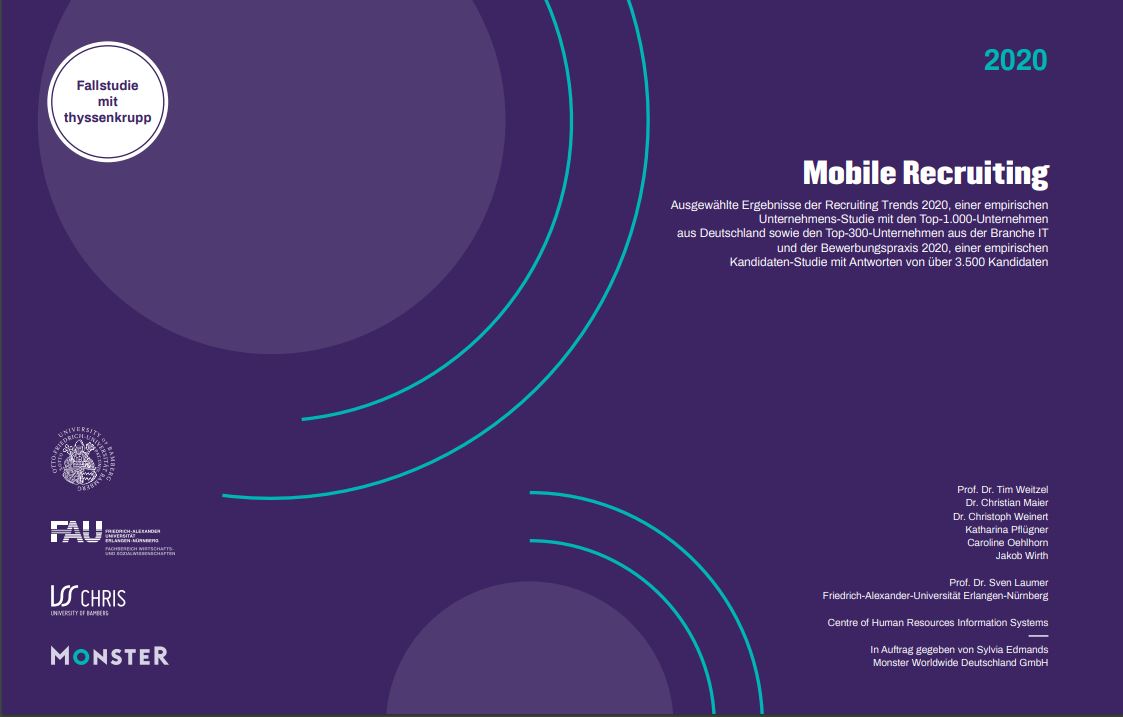 (2020)
(2020)
Generation Z - die Arbeitnehmer von morgen - Ausgewählte Ergebnisse der Recruiting Trends 2020 und der Bewerbungspraxis 2020
Research Report, Otto-Friedrich-Universität Bamberg
Weitzel, T., Maier, C., Weinert, C., Pflügner, K., Oehlhorn, C., Wirth, J., and Laumer, S.
 (2020)
(2020)
Digitalisierung und Zukunft der Arbeit - Ausgewählte Ergebnisse der Recruiting Trends 2020 und der Bewerbungspraxis 2020
Research Report, Otto-Friedrich-Universität Bamberg
Weitzel, T., Maier, C., Weinert, C., Pflügner, K., Oehlhorn, C., Wirth, J., and Laumer, S.
 (2020)
(2020)
Employer Branding - Ausgewählte Ergebnisse der Recruiting Trends 2020 und der Bewerbungspraxis 2020
Research Report, Otto-Friedrich-Universität Bamberg
Weitzel, T., Maier, C., Weinert, C., Pflügner, K., Oehlhorn, C., Wirth, J., and Laumer, S.
 (2020)
(2020)
Mobile Recruiting - Ausgewählte Ergebnisse der Recruiting Trends 2020 und der Bewerbungspraxis 2020
Research Report, Otto-Friedrich-Universität Bamberg
Weitzel, T., Maier, C., Weinert, C., Pflügner, K., Oehlhorn, C., Wirth, J., and Laumer, S.
 (2020)
(2020)
Social Recruiting und Active Sourcing - Ausgewählte Ergebnisse der Recruiting Trends 2020 und der Bewerbungspraxis 2020
Research Report, Otto-Friedrich-Universität Bamberg
Weitzel, T., Maier, C., Oehlhorn, C., Weinert, C., Wirth, J., and Laumer, S.
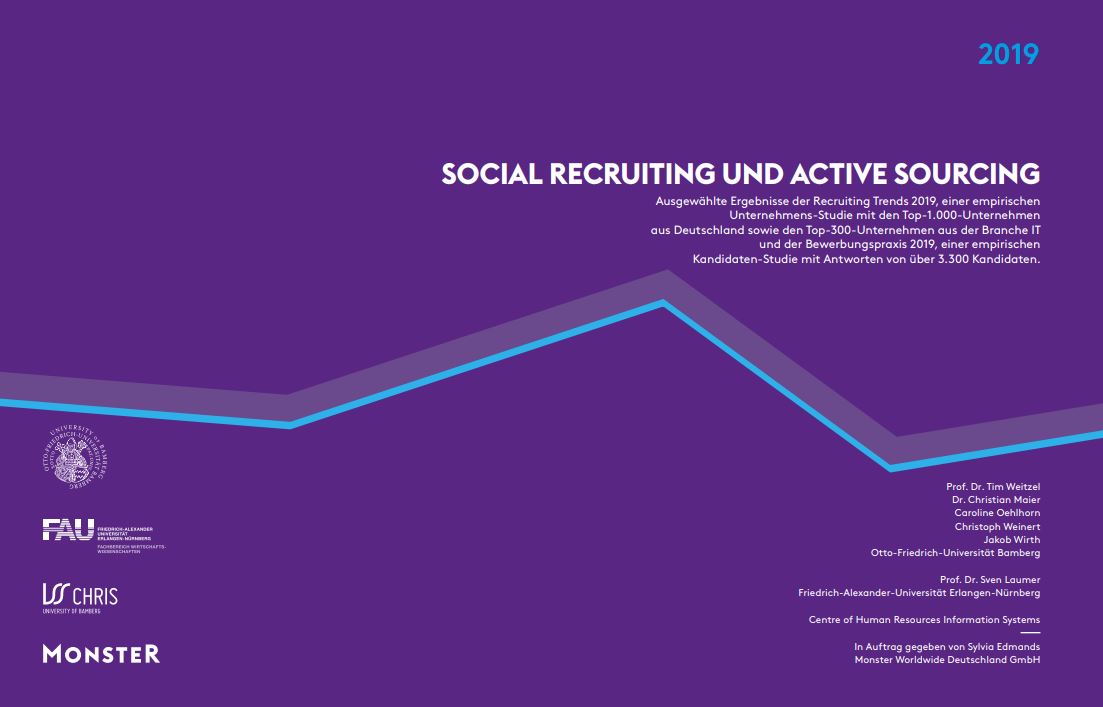 (2019)
(2019)
Mobile Recruiting - Ausgewählte Ergebnisse der Recruiting Trends 2019 und der Bewerbungspraxis 2019
Research Report, Otto-Friedrich-Universität Bamberg
Weitzel, T., Maier, C., Oehlhorn, C., Weinert, C., Wirth, J., and Laumer, S.
 (2019)
(2019)
Employer Branding - Ausgewählte Ergebnisse der Recruiting Trends 2019 und der Bewerbungspraxis 2019
Research Report, Otto-Friedrich-Universität Bamberg
Weitzel, T., Maier, C., Oehlhorn, C., Weinert, C., Wirth, J., and Laumer, S.
 (2019)
(2019)
Digitalisierung und Zukunft der Arbeit - Ausgewählte Ergebnisse der Recruiting Trends 2019 und der Bewerbungspraxis 2019
Research Report, Otto-Friedrich-Universität Bamberg
Weitzel, T., Maier, C., Oehlhorn, C., Weinert, C., Wirth, J., and Laumer, S.
 (2019)
(2019)
Social Recruiting und Active Sourcing - Ausgewählte Ergebnisse der Recruiting Trends 2019 und der Bewerbungspraxis 2019
Research Report, Otto-Friedrich-Universität Bamberg
Weitzel, T., Laumer, S., Maier, C., Oehlhorn, C., Weinert, C., and Wirth, J.
 (2018)
(2018)
Mobile Recruiting - Ausgewählte Ergebnisse der Recruiting Trends 2018 und der Bewerbungspraxis 2018
Research Report, Otto-Friedrich-Universität Bamberg
Weitzel, T., Laumer, S., Maier, C., Oehlhorn, C., Weinert, C., and Wirth, J.
 (2018)
(2018)
Employer Branding - Ausgewählte Ergebnisse der Recruiting Trends 2018 und der Bewerbungspraxis 2018
Research Report, Otto-Friedrich-Universität Bamberg
Weitzel, T., Laumer, S., Maier, C., Oehlhorn, C., Weinert, C., and Wirth, J.
 (2018)
(2018)
Digitalisierung der Personalgewinnung - Ausgewählte Ergebnisse der Recruiting Trends 2018 und der Bewerbungspraxis 2018
Research Report, Otto-Friedrich-Universität Bamberg
Weitzel, T., Laumer, S., Maier, C., Oehlhorn, C., Weinert, C., and Wirth, J.
 (2018)
(2018)
Social Recruiting und Active Sourcing - Ausgewählte Ergebnisse der Recruiting Trends 2018 und der Bewerbungspraxis 2018
Research Report, Otto-Friedrich-Universität Bamberg
Weitzel, T., Laumer, S., Maier, C., Oehlhorn, C., Wirth, J., Weinert, C., and Eckhardt, A.
 (2017)
(2017)
Employer Branding und Personalmarketing - Ausgewählte Ergebnisse der Recruiting Trends 2017 und der Bewerbungspraxis 2017
Research Report, Otto-Friedrich-Universität Bamberg
Weitzel, T., Laumer, S., Maier, C., Oehlhorn, C., Wirth, J., Weinert, C., and Eckhardt, A.
 (2017)
(2017)
Active Sourcing und Social Recruiting - Ausgewählte Ergebnisse der Recruiting Trends 2017 und der Bewerbungspraxis 2017
Research Report, Otto-Friedrich-Universität Bamberg
Weitzel, T., Laumer, S., Maier, C., Oehlhorn, C., Wirth, J., Weinert, C., and Eckhardt, A.
 (2017)
(2017)
Women in IT - Ausgewählte Ergebnisse der Recruiting Trends 2017 und der Bewerbungspraxis 2017
Research Report, Otto-Friedrich-Universität Bamberg
Weitzel, T., Laumer, S., Maier, C., Oehlhorn, C., Wirth, J., Weinert, C., and Eckhardt, A.
 (2017)
(2017)
Mobile Recruiting - Ausgewählte Ergebnisse der Recruiting Trends 2017 und der Bewerbungspraxis 2017
Research Report, Otto-Friedrich-Universität Bamberg
Weitzel, T., Laumer, S., Maier, C., Oehlhorn, C., Wirth, J., Weinert, C., and Eckhardt, A.
 (2017)
(2017)
Bewerbung der Zukunft - Ausgewählte Ergebnisse der Recruiting Trends 2017 und der Bewerbungspraxis 2017
Research Report, Otto-Friedrich-Universität Bamberg
Weitzel, T., Laumer, S., Maier, C., Oehlhorn, C., Wirth, J., Weinert, C., and Eckhardt, A.
 (2016)
(2016)
Employer Branding und Personalmarketing - Ausgewählte Ergebnisse der Recruiting Trends 2016 und der Bewerbungspraxis 2016
Research Report, Otto-Friedrich-Universität Bamberg
Weitzel, T., Laumer, S., Maier, C., Oehlhorn, C., Wirth, J., Weinert, C., and Eckhardt, A.
 (2016)
(2016)
Mobile Recruiting - Ausgewählte Ergebnisse der Recruiting Trends 2016 und der Bewerbungspraxis 2016
Research Report, Otto-Friedrich-Universität Bamberg
Weitzel, T., Laumer, S., Maier, C., Oehlhorn, C., Wirth, J., Weinert, C., and Eckhardt, A.
 (2016)
(2016)
Best Practices und 'Big Failures' in der Rekrutierung - Ausgewählte Ergebnisse der Recruiting Trends 2016 und der Bewerbungspraxis 2016
Otto-Friedrich-Universität Bamberg
Weitzel, T., Laumer, S., Maier, C., Oehlhorn, C., Wirth, J., Weinert, C., and Eckhardt, A.
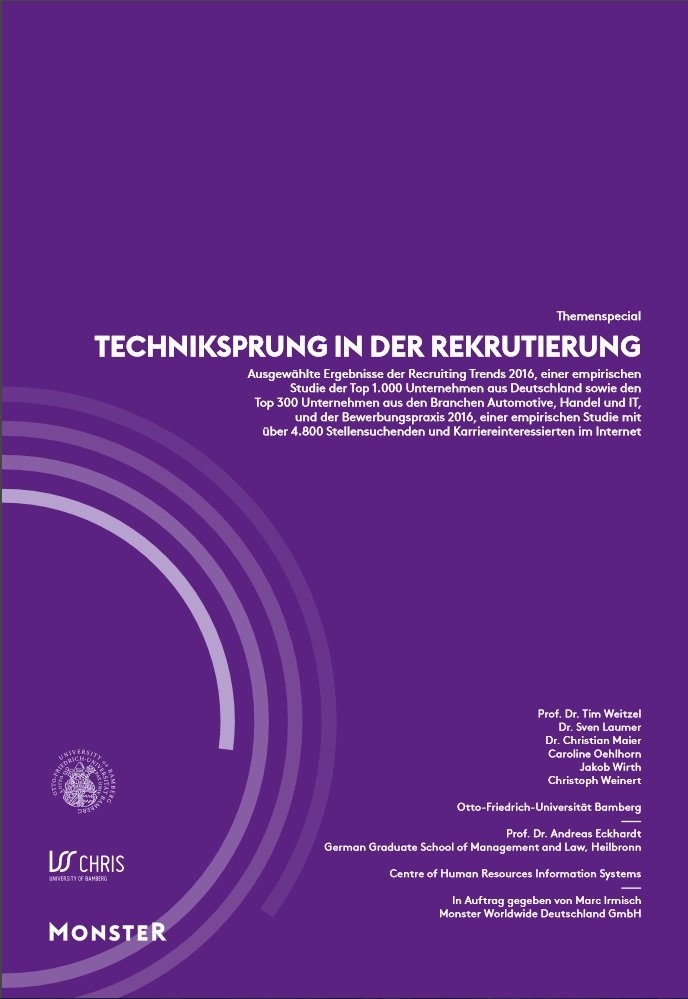 (2016)
(2016)
Bewerbung der Zukunft - Ausgewählte Ergebnisse der Recruiting Trends 2016 und der Bewerbungspraxis 2016
Research Report, Otto-Friedrich-Universität Bamberg
Weitzel, T., Laumer, S., Maier, C., Oehlhorn, C., Wirth, J., Weinert, C., and Eckhardt, A.
 (2016)
(2016)
Techniksprung in der Rekrutierung - Ausgewählte Ergebnisse der Recruiting Trends 2016 und der Bewerbungspraxis 2016
Research Report, Otto-Friedrich-Universität Bamberg
Weitzel, T., Laumer, S., Maier, C., Oehlhorn, C., Wirth, J., Weinert, C., and Eckhardt, A.
 (2016)
(2016)
Active Sourcing und Social Recruiting - Ausgewählte Ergebnisse der Recruiting Trends 2016 und der Bewerbungspraxis 2016
Research Report, Otto-Friedrich-Universität Bamberg
Maier, C., Laumer, S., Weitzel, T., Weinert, C., von Stetten, A., Wirth, J., Eckhardt, A., and Kraft, B.
 (2015)
(2015)
Bewerbungspraxis 2015 - Eine empirische Studie mit 7.000 Stellensuchenden und Karriereinteressierten im Internet
Research Report, Otto-Friedrich-Universität Bamberg
von Stetten, A., Laumer, S., Maier, C., Weinert, C., Weitzel, T., Wirth, J., Eckhardt, A., and Kraft, B.
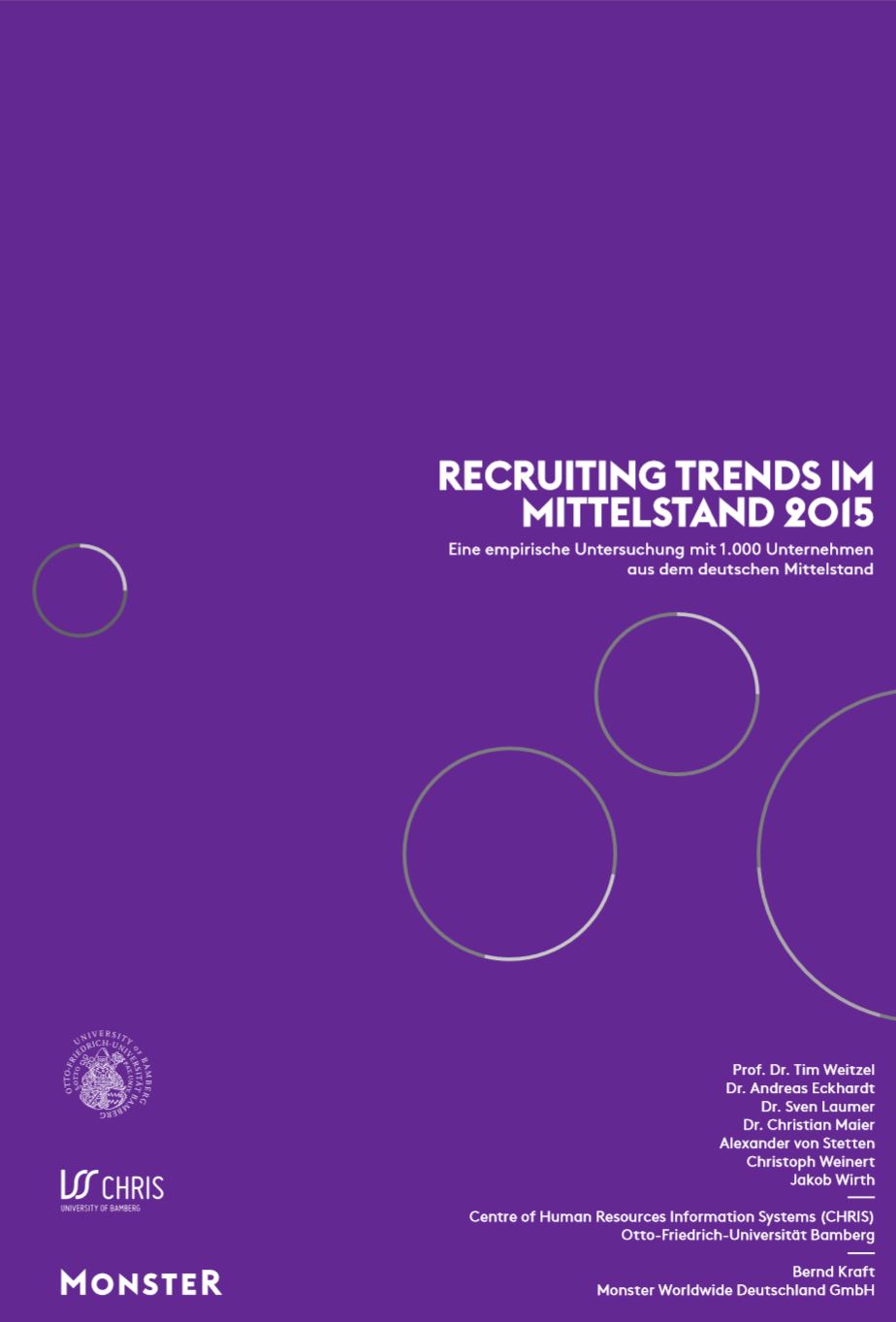 (2015)
(2015)
Recruiting Trends im Mittelstand 2015 - Eine empirische Untersuchung mit 1.000 Unternehmen aus dem deutschen Mittelstand
Research Report, Otto-Friedrich-Universität Bamberg
Weinert, C., Wirth, J., von Stetten, A., Laumer, S., Maier, C., Weitzel, T., Eckhardt, A., and Kraft, B.
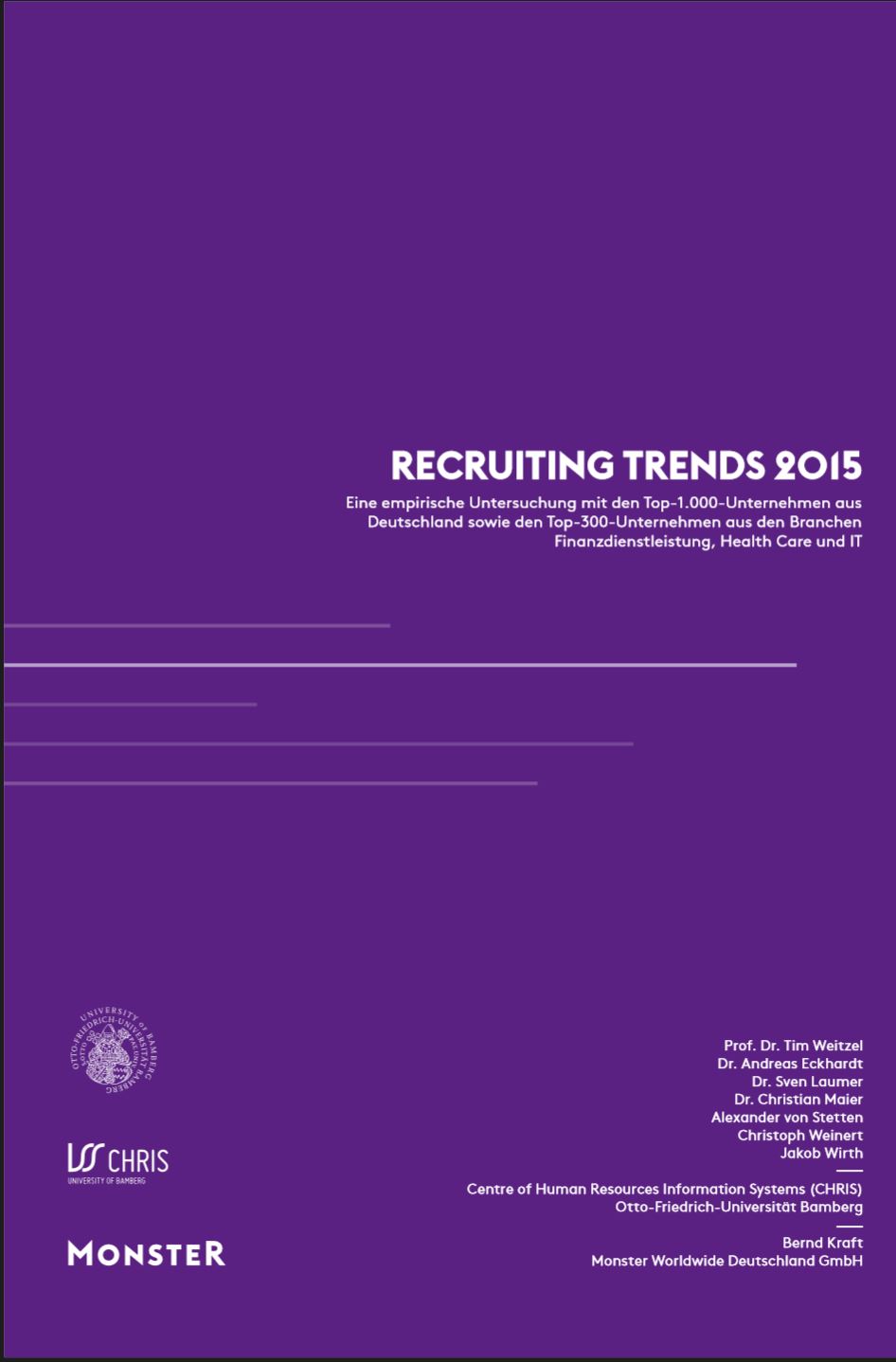 (2015)
(2015)
Recruiting Trends 2015 - Eine empirische Untersuchung mit den Top-1.000-Unternehmen aus Deutschland, sowie den Top-300-Unternehmen aus den Branchen Finanzdienstleistung, Health Care und IT
Research Report, Otto-Friedrich-Universität Bamberg
Weinert, C., von Stetten, A., Laumer, S., Maier, C., Weitzel, T., and Eckhardt, A.
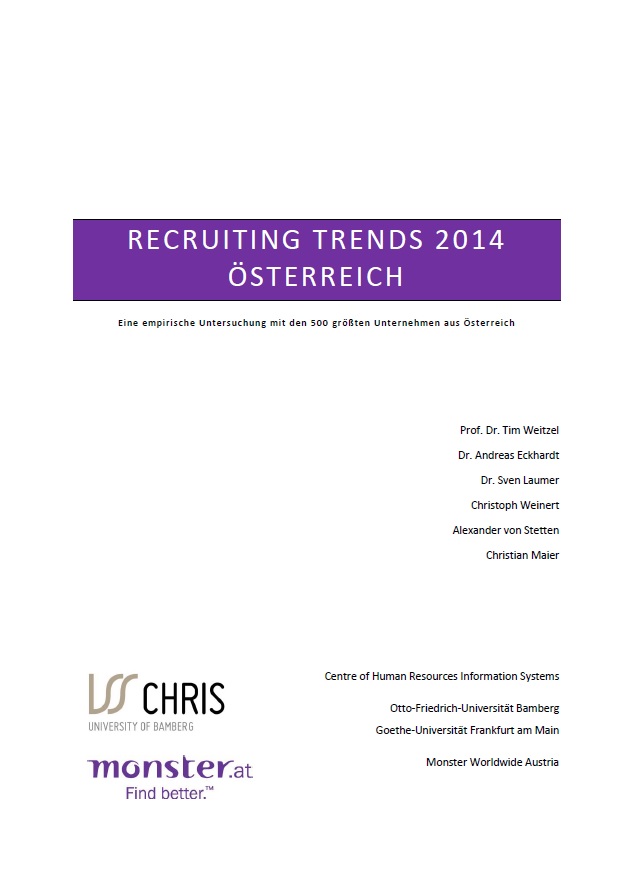 (2014)
(2014)
Recruiting Trends 2014 Österreich - Eine empirische Untersuchung mit den 500 größten Unternehmen aus Österreich
Research Report, Otto-Friedrich-Universität Bamberg und Goethe-Universität Frankfurt am Main
von Stetten, A., Laumer, S., Maier, C., Weinert, C., Weitzel, T., Eckhardt, A., and Kraft, B.
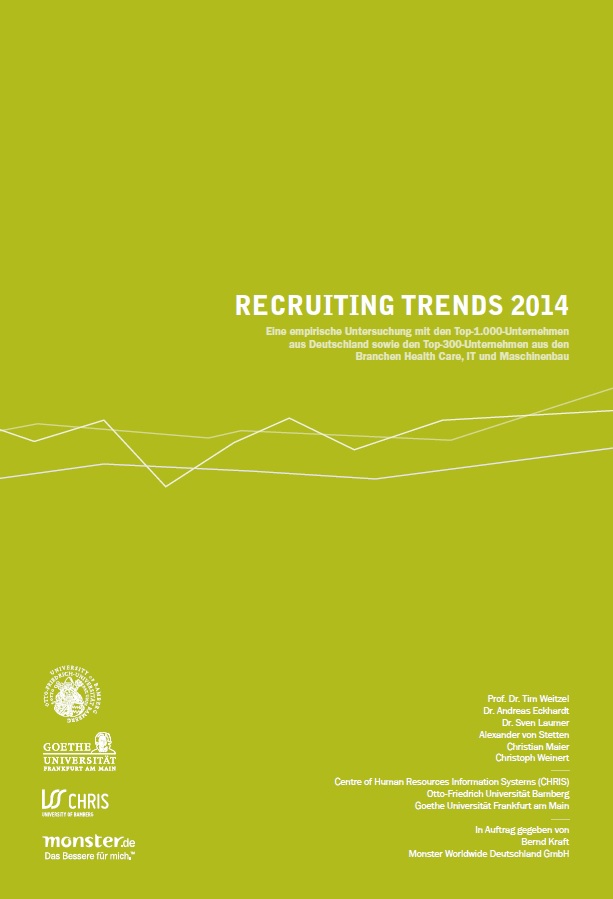 (2014)
(2014)
Recruiting Trends 2014 - Eine empirische Untersuchung mit den Top-1.000-Unternehmen aus Deutschland sowie den Top-300-Unternehmen aus den Branchen Health Care, IT und Maschinenbau
Research Report, Otto-Friedrich-Universität Bamberg und Goethe-Universität Frankfurt am Main
Maier, C., Laumer, S., Weinert, C., von Stetten, A., Weitzel, T., Eckhardt, A., and Kraft, B.
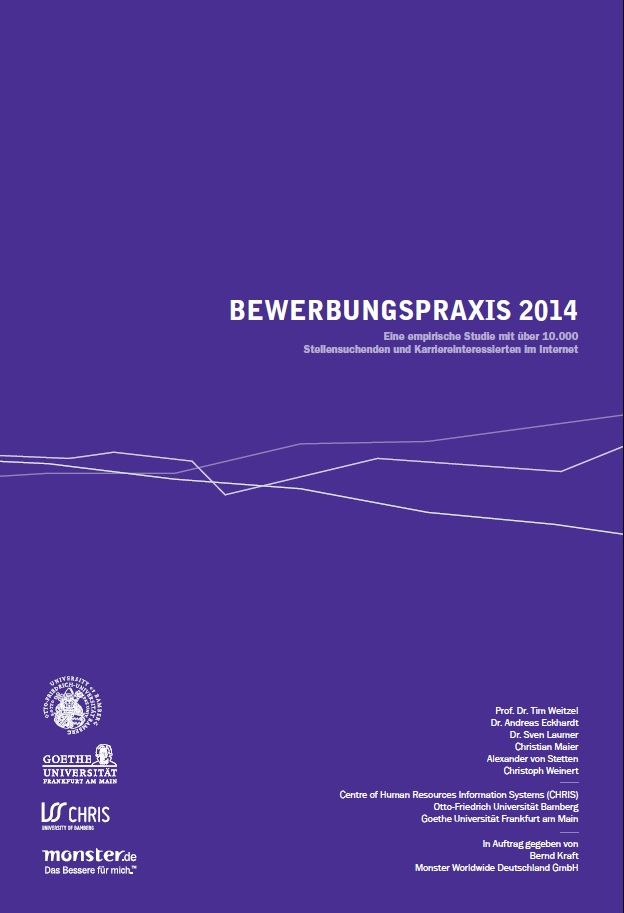 (2014)
(2014)
Bewerbungspraxis 2014 - Eine empirische Studie mit über 10.000 Stellensuchenden und Karriereinteressierten im Internet
Research Report, Otto-Friedrich-Universität Bamberg und Goethe-Universität Frankfurt am Main
Weinert, C., Laumer, S., Maier, C., von Stetten, A., Weitzel, T., and Eckhardt, A.
 (2013)
(2013)
Recruiting Trends 2013 Österreich - Eine empirische Untersuchung mit den 500 größten Unternehmen aus Österreich
Research Report, Otto-Friedrich-Universität Bamberg und Goethe-Universität Frankfurt am Main
 (2015)
(2015) (2015)
(2015) (2020)
(2020) (2020)
(2020) (2020)
(2020) (2020)
(2020) (2020)
(2020) (2019)
(2019) (2019)
(2019) (2019)
(2019) (2019)
(2019) (2018)
(2018) (2018)
(2018) (2018)
(2018) (2018)
(2018) (2017)
(2017) (2017)
(2017) (2017)
(2017) (2017)
(2017) (2017)
(2017) (2016)
(2016) (2016)
(2016) (2016)
(2016) (2016)
(2016) (2016)
(2016) (2016)
(2016) (2015)
(2015)
(2015)
 (2014)
(2014) (2014)
(2014) (2014)
(2014) (2013)
(2013)